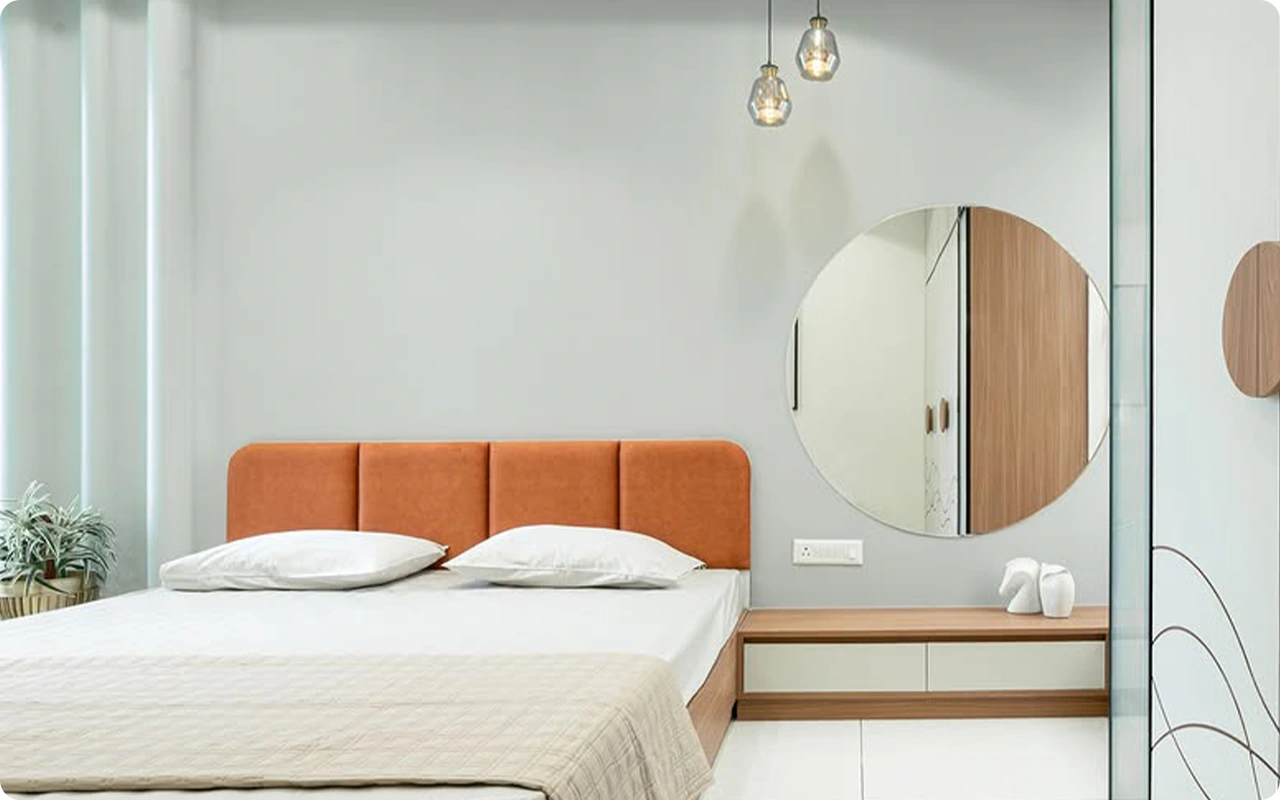If there’s one space in your home that truly deserves a calming, restful atmosphere, it’s your bedroom. After all, it’s where you begin and end each day, and the colors on your walls play a huge role in setting the mood.
The right shade can make a room feel like a peaceful retreat, while the wrong one might leave you feeling restless or uninspired.
For 2025, the focus is on soft, nature-inspired hues that bring warmth, serenity, and a touch of sophistication to your personal haven.
Think gentle blues reminiscent of the sky, warm neutrals that feel like a cozy hug, and muted greens that reflect the tranquility of nature.
Whether you prefer something light and airy or a slightly deeper shade that adds depth while still feeling soothing, there’s a color that will work beautifully in your space.
In this post, I’ll walk you through 19 of the best calming bedroom paint colors for 2025, along with styling tips and common mistakes to avoid.
By the end, you’ll have all the inspiration you need to create a bedroom that feels effortlessly relaxing and inviting.
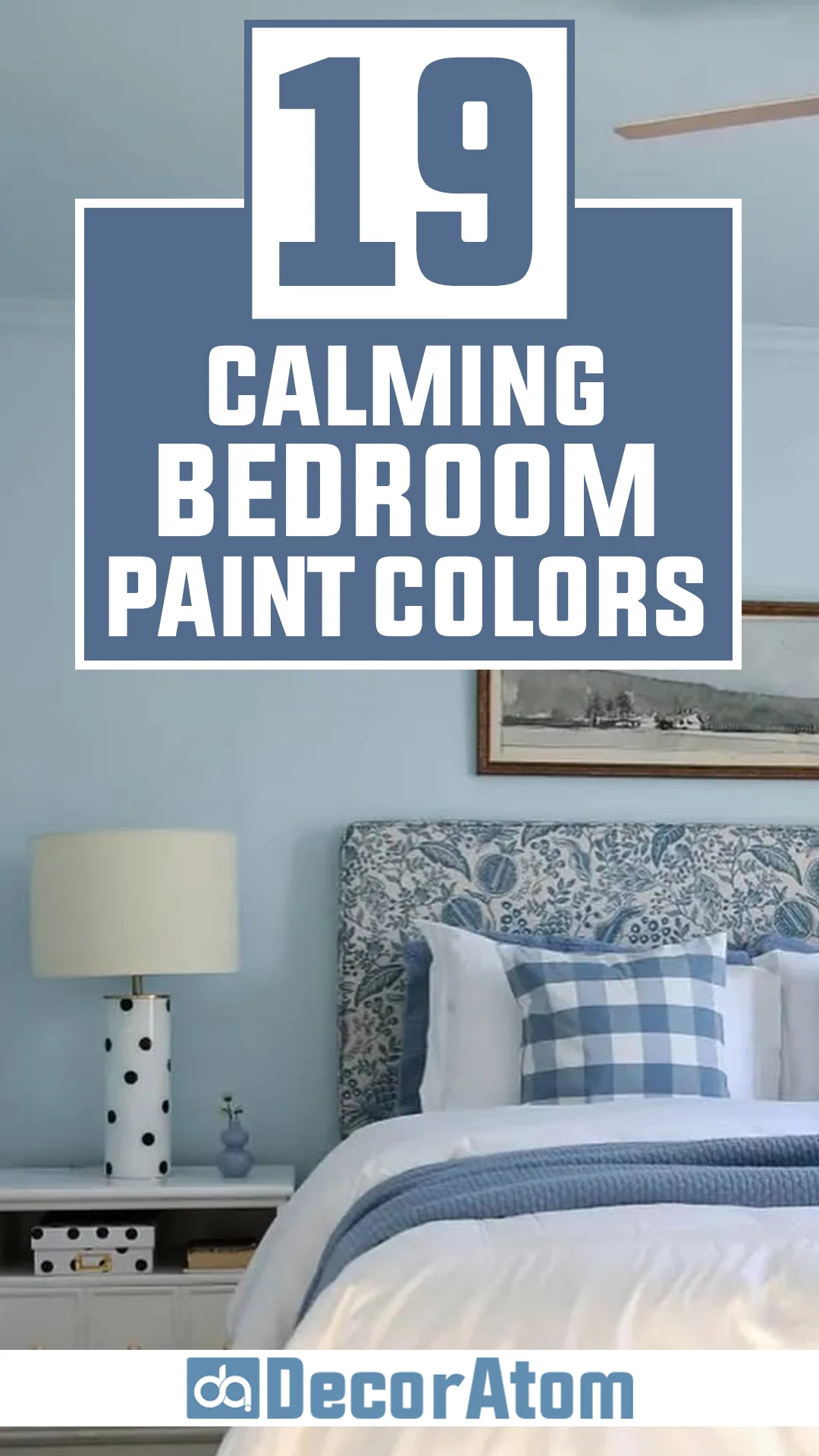
Color Pairing & Styling Tips to Create a Calming Bedroom
Choosing the right paint color is just the first step in designing a truly calming bedroom. The way you style the space, from furniture choices to décor accents, plays a huge role in reinforcing that sense of tranquility. Here are some key tips to help you bring everything together:
1. Keep the Color Palette Soft & Harmonious
A calming bedroom thrives on a balanced, cohesive color palette. If your walls are a soft blue, green, or neutral, stick with complementary shades in your bedding, curtains, and décor. Earthy tones, whites, and warm grays work beautifully as supporting colors.
2. Layer in Soft, Natural Textures
Fabrics and materials matter just as much as color when it comes to creating a relaxing space. Opt for plush bedding, linen curtains, and soft wool or cotton rugs. Woven baskets, wood furniture, and stone elements add an organic, grounding effect.
3. Keep Lighting Warm & Adjustable
Harsh, bright lighting can ruin the calming effect of a well-chosen paint color. Opt for warm white bulbs, dimmable fixtures, or bedside lamps with soft, diffused light to create a cozy glow in the evenings.
4. Declutter & Keep the Décor Minimal
A cluttered bedroom can feel anything but relaxing. Keep surfaces clean and limit decorative items to just a few meaningful or aesthetically pleasing pieces. A well-placed piece of artwork, a plant, or a ceramic vase can enhance the space without overwhelming it.
5. Bring in Nature for a Restorative Feel
Houseplants, dried flowers, or even landscape artwork can amplify the calming effect of your paint color. Shades of green, in particular, pair beautifully with natural elements, reinforcing a sense of tranquility and connection to nature.

Common Mistakes to Avoid (What NOT to Do When Choosing a Calming Paint Color for Your Bedroom)
Even the most beautiful paint color can feel off if it’s not chosen or used correctly. Here are some common mistakes that can disrupt the soothing atmosphere you’re aiming for:
1. Choosing a Color That’s Too Cool or Too Warm
While blues and greens are naturally calming, some shades can lean too icy or overly yellow, making the room feel uninviting. A good rule of thumb is to pick soft, muted versions of your favorite color rather than anything too stark or saturated.
2. Ignoring the Room’s Natural Lighting
Lighting dramatically affects how a paint color looks. A color that appears soft and dreamy in a well-lit showroom might look dark or dull in a bedroom with limited natural light. Always test swatches at different times of the day before committing to a shade.
3. Using Too Many Contrasting Colors
A calming bedroom should feel cohesive, not chaotic. Avoid using colors that are too high-contrast, such as pairing a soft sage green with a bright white trim. Instead, opt for warmer whites or off-whites that blend seamlessly with your chosen wall color.
4. Forgetting About Undertones
A color might look perfect in the store, but once it’s on your walls, it may reveal hidden undertones that clash with your furniture or décor. Always compare swatches against your existing furniture and flooring before making a final decision.
5. Overloading the Room with Dark Colors
While deeper hues can be calming, too much darkness in a bedroom can feel heavy or even a little gloomy. If you love a moody paint color, balance it with light, airy bedding, curtains, and furniture to maintain a restful vibe.
6. Neglecting the Ceiling & Trim
The ceiling and trim can enhance or disrupt your calming color scheme. Instead of stark white, consider a soft white or pale neutral that complements your wall color for a more seamless and soothing look.
19 Best Calming Paint Colors for a Bedroom
Here are 19 of the Best Calming Paint Colors for a Bedroom in 2025. Each of these shades is chosen for its soothing qualities, ability to enhance relaxation, and timeless appeal.
Soft Blues: Tranquil & Airy
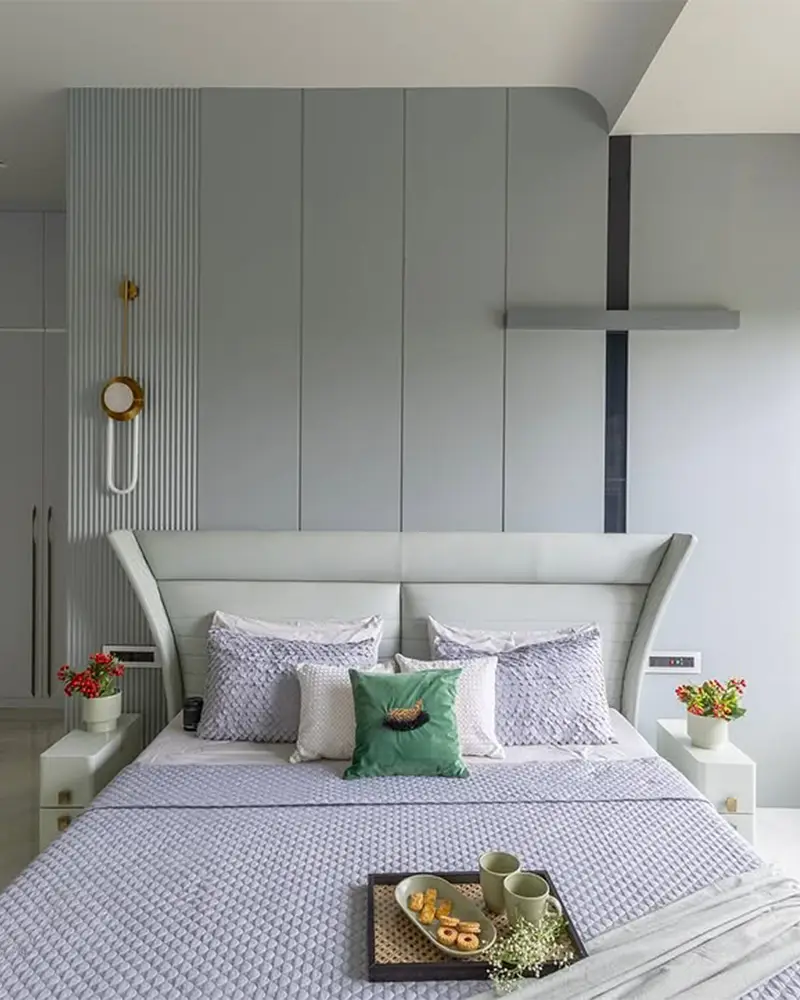
💥🎁 Christmas & Year-End Deals On Amazon !
Don't miss out on the best discounts and top-rated products available right now!
*As an Amazon Associate, I earn from qualifying purchases.
If you’re dreaming of a bedroom that feels light, peaceful, and effortlessly relaxing, soft blue is one of the best choices.
These shades have a natural way of making a space feel open and breathable—like a gentle breeze through sheer curtains on a quiet morning. But not all blues are created equal.
Some can feel too bright, too cold, or too vibrant for a truly restful retreat.
That’s why the best calming blues have a touch of gray or green, keeping them soft and sophisticated rather than overpowering.
1. Sherwin Williams Sleepy Blue

Think of the sky just before dawn, when everything is still hushed, and the world hasn’t fully woken up yet. That’s the feeling Sleepy Blue creates in a bedroom.
It’s a muted, powdery blue with just the right amount of gray to keep it from feeling too bright or babyish. If you love blue but worry about it looking too childish or overwhelming, Sleepy Blue is the perfect balance.
This shade works beautifully with crisp white bedding and natural wood furniture, making the entire space feel fresh and open. It pairs especially well with soft grays and creamy whites, keeping the overall look cohesive and calming.
Whether your bedroom gets a lot of natural light or not, Sleepy Blue stays soft and relaxed throughout the day.
2. Benjamin Moore Palladian Blue

There’s something about Palladian Blue that feels like a deep breath of fresh air. It’s a soft blue with hints of green and a touch of gray, giving it an airy, almost ethereal quality.
This isn’t a straightforward blue—it shifts depending on the light, sometimes leaning more toward a misty seafoam, sometimes feeling like a gentle sky before a storm rolls in.
Because of its delicate mix of blue, green, and gray, Palladian Blue is perfect for creating a spa-like atmosphere. It pairs beautifully with warm whites, linen textures, and soft, sandy neutrals, making it an excellent choice if you want a space that feels effortlessly serene.
If your bedroom has a lot of natural light, this shade glows beautifully throughout the day, never feeling too cool or stark.
3. Sherwin Williams Misty

💥🎁 Christmas & Year-End Deals On Amazon !
Don't miss out on the best discounts and top-rated products available right now!
*As an Amazon Associate, I earn from qualifying purchases.
Misty is one of those colors that instantly makes a room feel lighter and airier. It’s a cool, silvery blue with a strong gray undertone, which keeps it from ever feeling too bold or overwhelming.
Instead, it has a whisper-soft quality—like the sky on a foggy morning, just before the sun starts to break through.
This color is perfect if you want a bedroom that feels refreshing but not cold. It has a crispness to it, but the soft gray undertone ensures it still feels inviting.
Pair it with soft white trim, warm wood accents, and layered neutral textiles to create a space that feels balanced and calm. If your room tends to feel dark, Misty can help brighten things up without making the space feel too stark.
4. Farrow & Ball Skylight

Skylight is one of those colors that’s hard to define but impossible to forget. It has an ethereal, almost weightless quality—like looking up at the sky on a softly overcast day.
It’s a gentle blue with just a hint of warmth, making it feel inviting rather than chilly.
This shade works beautifully in bedrooms that receive a lot of natural light, as it reflects brightness while still maintaining its soft, calming presence.
Skylight pairs especially well with creamy whites, warm grays, and soft, aged woods, making it a great option for a timeless, elegant retreat.
If you’re looking for a blue that doesn’t feel too obviously “blue” but still brings a sense of tranquility, Skylight is a perfect choice.
Soft Greens: Nature’s Soothing Touch
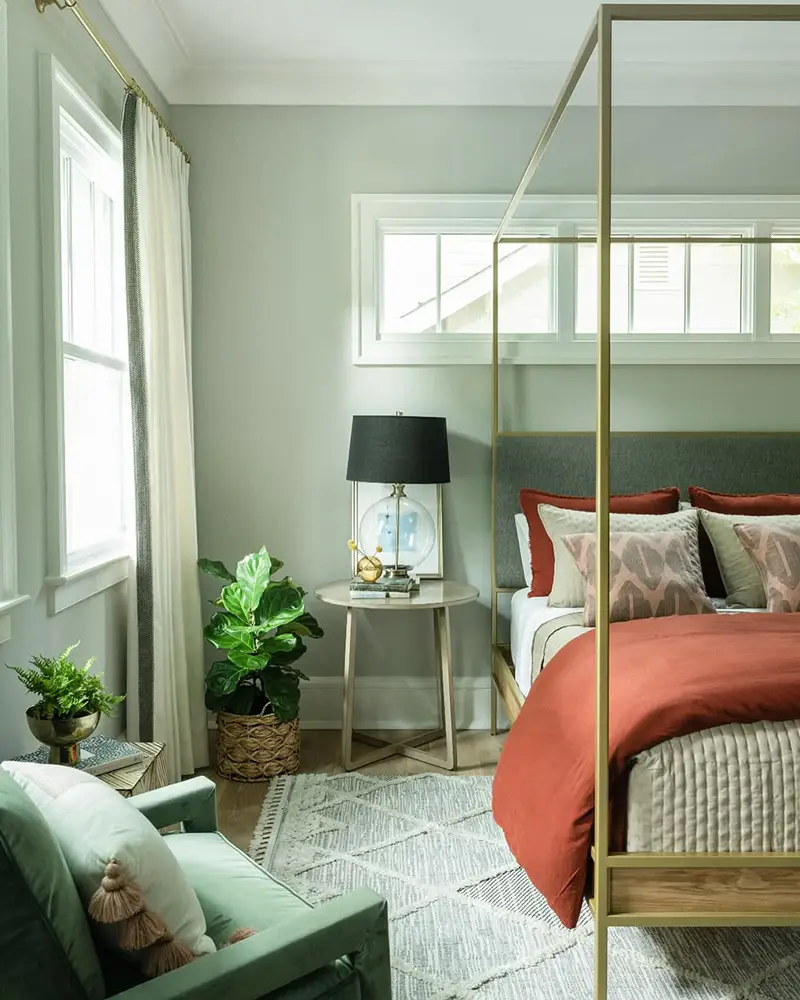
There’s something about soft green that just feels right in a bedroom. Maybe it’s the connection to nature—those calming tones you see in fresh leaves, mossy trails, and misty meadows.
Or maybe it’s the way green instantly brings a sense of balance, grounding a space without feeling too heavy.
The best soft greens for a bedroom have subtle undertones—whether it’s a whisper of yellow, a hint of blue, or a touch of gray—that make them versatile and timeless.
These shades aren’t just colors; they create an atmosphere, transforming your bedroom into a retreat where you can breathe easy and unwind.
5. Benjamin Moore Soft Fern

💥🎁 Christmas & Year-End Deals On Amazon !
Don't miss out on the best discounts and top-rated products available right now!
*As an Amazon Associate, I earn from qualifying purchases.
Soft Fern is the kind of green that feels like a gentle exhale. It’s light and delicate, with just a touch of yellow to keep it warm and inviting. This isn’t a bold or overly saturated green—it’s subtle, like the fresh, tender green of new leaves in early spring.
If you love the idea of green but don’t want it to feel too strong, Soft Fern is an excellent choice. It has an organic, effortless quality that makes a bedroom feel serene without overwhelming the space.
Because of its slight yellow undertone, it pairs beautifully with warm neutrals like soft beiges, warm whites, and natural wood tones. If your bedroom gets a lot of sunlight, Soft Fern will take on a soft glow, making the space feel even cozier.
6. Sherwin Williams Sea Salt

Sea Salt is one of those colors that changes throughout the day, keeping things interesting while always remaining calm and soothing. It’s a soft green with strong blue-gray undertones, meaning it never feels too vibrant or too warm.
Instead, it shifts in different lighting conditions—sometimes leaning more green, sometimes more blue, and occasionally even looking like a muted gray-green mist.
This color is a favorite for coastal and minimalist bedrooms because of its spa-like quality. It’s the perfect backdrop for white linens, rattan furniture, and light, breezy fabrics.
If your room gets a lot of natural light, Sea Salt will appear brighter and slightly more green. In dimmer rooms, it takes on a moodier blue-gray tone. Either way, it’s an easy, versatile choice that creates a peaceful and airy retreat.
7. Benjamin Moore Saybrook Sage

If you’re drawn to muted, earthy tones, Saybrook Sage might be your perfect bedroom green. It’s a true sage—soft and subdued, with just enough depth to feel sophisticated without being too dark.
There’s a balance to this color that makes it feel effortlessly calming. It’s not too cool, not too warm—just a perfect, natural green with a hint of gray to keep it from feeling too vibrant.
Saybrook Sage works beautifully in a bedroom with warm wood tones, like oak or walnut, and pairs well with creamy white trim. It’s the kind of green that feels timeless, making your bedroom feel cozy and grounded without looking trendy or overly styled.
If you want a color that brings a sense of calm while still having enough personality to feel intentional, Saybrook Sage is a fantastic choice.
8. Sherwin Williams Evergreen Fog

💥🎁 Christmas & Year-End Deals On Amazon !
Don't miss out on the best discounts and top-rated products available right now!
*As an Amazon Associate, I earn from qualifying purchases.
Evergreen Fog is a deeper, moodier take on soft green. It has a strong gray influence, which gives it an earthy, grounded feel—like a misty forest in the early morning. It’s a fantastic choice if you want a bedroom that feels soothing but also has a bit of richness and depth.
Because Evergreen Fog leans into its gray undertones, it pairs beautifully with warm neutrals, soft whites, and even darker wood tones like walnut or espresso. It’s a great option if you love the idea of green but want something that feels modern and understated.
This color works especially well in bedrooms with soft, layered textiles—think linen bedding, woven rugs, and plush throws—to enhance its cozy, nature-inspired feel. If you want a green that feels both relaxing and sophisticated, Evergreen Fog strikes the perfect balance.
Warm Neutrals: Cozy & Inviting

There’s something undeniably comforting about warm neutrals in a bedroom. These colors create a sense of ease, wrapping you in softness without overwhelming the space.
The key to a great warm neutral is balance—it should feel cozy but not heavy, warm but not overly yellow, and soft without looking flat.
The best warm neutrals have subtle undertones of beige, gray, or cream, making them adaptable to any bedroom style, from modern minimalism to rustic farmhouse charm.
9. Sherwin Williams Accessible Beige

Accessible Beige is the kind of color that instantly makes a bedroom feel more inviting. It sits right between beige and greige, meaning it has the warmth of a classic beige but with enough gray influence to keep it from feeling outdated or too golden.
It’s one of those colors that adapts to its surroundings, working equally well in rooms with lots of natural light and in dimmer spaces where you want to create a cozy retreat.
This shade pairs beautifully with soft white trim, warm wood furniture, and textured fabrics like linen or boucle. If your bedroom leans towards a more organic, earthy aesthetic, Accessible Beige will fit right in.
It’s also a great choice if you like to change up your décor often—it plays well with everything from deep blues and greens to warm terracotta tones.
10. Benjamin Moore Balboa Mist

💥🎁 Christmas & Year-End Deals On Amazon !
Don't miss out on the best discounts and top-rated products available right now!
*As an Amazon Associate, I earn from qualifying purchases.
If you love the idea of a warm neutral but don’t want anything too beige, Balboa Mist might be your perfect match. This color is technically a warm gray, but it has just enough beige undertones to keep it feeling soft and inviting rather than cool or stark.
It’s one of those chameleon-like shades that shift throughout the day—sometimes looking more gray in shadowy corners and taking on a subtle warmth in brighter spaces.
Balboa Mist works well if you’re aiming for a serene, elegant bedroom. It pairs beautifully with both modern and traditional elements, making it a versatile choice whether you prefer crisp white bedding or cozy layers of warm neutrals.
It also plays well with warm metals like brass and gold, adding a sophisticated touch to your space.
11. Sherwin Williams Drift of Mist

Drift of Mist is the ultimate barely-there warm gray. It’s incredibly soft, with just enough warmth to keep it from feeling cold but not so much that it reads as beige.
This is the kind of color that enhances natural light, making your bedroom feel airy and peaceful. If you love a clean, minimal aesthetic but still want warmth in your space, Drift of Mist is an excellent choice.
This shade looks stunning with light wood furniture, soft linen curtains, and layered neutral bedding. It has a sophisticated, effortless quality—perfect for those who want a color that works quietly in the background while letting textures and furnishings take center stage.
12. Benjamin Moore Swiss Coffee

Swiss Coffee is the definition of a soft, creamy off-white. It has a warmth to it that makes a bedroom feel instantly welcoming, like the glow of morning sunlight filtering through sheer curtains.
If you love the idea of an all-white bedroom but want a hint of coziness, Swiss Coffee is the perfect in-between shade—it’s not stark like a pure white, but it’s also not so yellow that it feels heavy.
This color pairs beautifully with natural materials—think woven baskets, linen bedding, and soft wool throws. It’s also a great choice if you want a neutral that won’t clash with warmer wood tones or brass accents.
Whether your bedroom leans toward classic, farmhouse, or even modern boho, Swiss Coffee adds just the right amount of warmth to make the space feel inviting.
13. Sherwin Williams Shoji White

Shoji White is a beautifully balanced neutral that sits between white and beige, with subtle gray undertones that prevent it from feeling too warm or too cool.
It’s a fantastic choice if you want a soft, neutral backdrop that still has a bit of depth. Unlike stark whites, Shoji White feels warm and comforting, making your bedroom feel like a peaceful retreat.
This color works well in bedrooms that get plenty of natural light, where its creamy warmth really shines. It also pairs effortlessly with soft whites and warm woods, creating a cozy, layered look.
If you’re looking for a neutral that makes your space feel bright but not sterile, Shoji White is a great pick. It has just the right amount of warmth to feel inviting while still keeping things fresh and airy.
Muted Grays & Greiges: Elegant & Relaxing
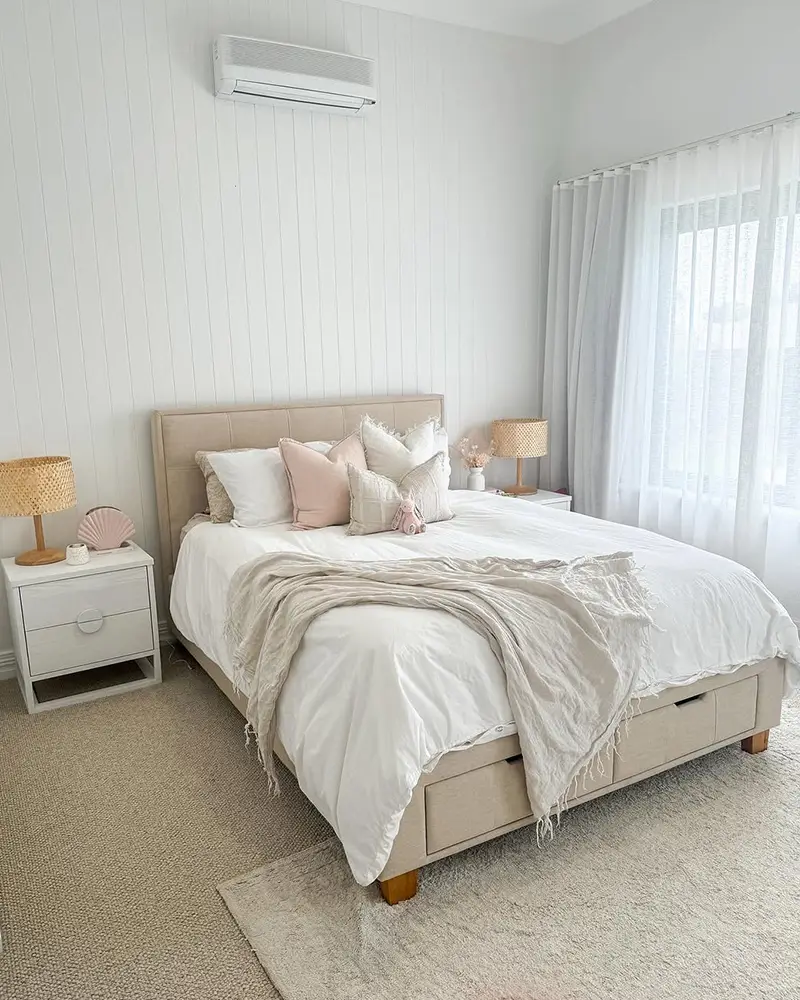
If you want a bedroom that feels effortlessly stylish and calming, muted grays and greiges are the way to go. These shades have a soft, airy quality that creates an elegant backdrop without overwhelming the space.
The key to choosing the right muted gray or greige is in the undertones—some have a touch of warmth, keeping them from feeling too cold, while others lean closer to off-white for an ultra-light and breezy look.
These colors are perfect if you want a bedroom that feels sophisticated but still inviting, with just the right amount of depth to add interest without distraction.
14. Benjamin Moore Classic Gray

Classic Gray is one of those barely-there colors that subtly enhances a bedroom without calling too much attention to itself. It leans toward off-white but has a soft gray undertone that gives it a whisper of depth, making it an ideal choice if you want a light and airy space that still feels warm and inviting.
Unlike cooler grays that can sometimes feel stark, Classic Gray carries a hint of warmth, ensuring that your bedroom remains cozy rather than sterile.
This color is incredibly versatile. In bright, sun-filled rooms, it can appear almost like a soft, warm white, while in dimmer spaces, its gentle gray undertones come forward, adding a sense of depth.
It pairs beautifully with crisp white trim for a clean, timeless look and works especially well with warm wood furniture and plush neutral bedding. If you love the idea of a barely-there color that still adds sophistication, Classic Gray is a fantastic option.
15. Sherwin Williams Repose Gray

Repose Gray is the perfect balance of warmth and softness in a gray. It has subtle warm undertones that keep it from feeling cold or overly modern, making it an excellent choice for a bedroom that feels inviting and serene.
This is a color that works well with almost any style—whether you have a more traditional space with classic furniture or a modern bedroom with sleek lines, Repose Gray adapts beautifully.
One of its best qualities is its versatility in different lighting conditions. In natural light, Repose Gray appears as a soft, warm gray with a hint of greige, but in darker spaces, its depth comes through a bit more, creating a cozy and grounded atmosphere.
It pairs wonderfully with warm whites, beige, and even muted blues or greens if you want a bit of contrast. If you’re looking for a gray that feels effortless and pairs well with nearly everything, Repose Gray is a solid choice.
16. Farrow & Ball Ammonite

Ammonite is a refined, pale gray that carries just the slightest hint of warmth, making it feel soothing and sophisticated without looking too beige.
It’s one of those colors that can shift depending on the surrounding elements—it can read as a soft, cool-toned gray in some spaces or pick up a touch of warmth in others.
This adaptability makes it an excellent choice if you want a neutral that can blend seamlessly into your bedroom without feeling too stark or too warm.
The beauty of Ammonite is in its subtlety. It doesn’t scream for attention but instead provides a perfect, polished backdrop for a restful space.
It pairs beautifully with crisp whites for a classic, airy feel, or you can bring in creams and soft wood tones for a more layered, inviting look. This is an ideal color if you love the idea of a minimalist but cozy bedroom—clean, elegant, and endlessly relaxing.
Soft White: Bright Yet Relaxing

If you’re drawn to the idea of a white bedroom but don’t want it to feel cold or sterile, soft whites are the perfect middle ground. These shades maintain that fresh, airy feeling of white while bringing in enough warmth or depth to make the space feel cozy and inviting.
Soft whites have a certain charm that doesn’t overpower the room, allowing you to build a calm, serene environment. They work especially well in bedrooms, where you want a light-filled, peaceful atmosphere without sacrificing comfort.
Let’s explore some soft whites that can transform your bedroom into a bright yet relaxing retreat.
17. Benjamin Moore Chantilly Lace

Chantilly Lace is a crisp white that feels fresh and clean, but it doesn’t have the harsh, clinical edge that some stark whites can have.
It’s one of those whites that provides an airy, open feeling in a room, while still having enough softness to prevent it from feeling sterile. If you love the idea of a white bedroom that’s light and bright but still cozy, this is your go-to.
The beauty of Chantilly Lace lies in its versatility. It pairs well with almost anything, from deep accent colors to light, soft pastels.
Its crisp nature makes it ideal for a minimalist bedroom where you want the color palette to stay simple and clean, yet it’s soft enough to avoid feeling like a hospital room.
It’s perfect for balancing the warmth of wooden furniture or the coolness of modern, sleek pieces. Whether you have modern, traditional, or even bohemian décor, Chantilly Lace can seamlessly tie everything together.
18. Sherwin Williams Alabaster

Alabaster is a warm, creamy white that’s everything but harsh. Unlike the more neutral whites that can sometimes feel stark, Alabaster has just a touch of beige, which gives it a lovely softness and warmth.
This is the kind of white that can fill your bedroom with light but still make the space feel inviting. It’s not cold or clinical like some whites—it’s comforting and homely.
The great thing about Alabaster is how it works with natural light. It gently softens the light in your room, making the space feel bright without being overpowering.
It’s a fantastic choice if you’re looking to create a cozy, serene bedroom. Pair it with layered bedding in soft textures—think fluffy white duvets, warm throws, and pillows in neutral tones.
Add in some natural wood accents, and Alabaster transforms your bedroom into a relaxing retreat. The color complements everything from earthy neutrals to bolder, darker tones, giving you plenty of flexibility with your décor.
19. Benjamin Moore White Dove

White Dove is a soft off-white with warm undertones that brings a welcoming, peaceful glow to any bedroom. Unlike some whites that can feel a little too harsh or cold, White Dove adds a layer of warmth that makes your space feel more inviting.
It’s not quite beige, but it definitely has enough depth to keep it from feeling flat.
This white creates a serene, light-filled atmosphere while still maintaining a sense of coziness. It pairs effortlessly with a wide range of colors—soft grays, muted pastels, warm beiges, and even subtle greens or blues.
If you’re after a bedroom that’s calm and tranquil, White Dove is a great option. It works well with both traditional and modern styles, complementing everything from plush linens to sleek metal finishes.
It’s a versatile white that keeps the space feeling fresh but not overly stark, and it’s perfect for creating a bedroom that’s both airy and peaceful.

